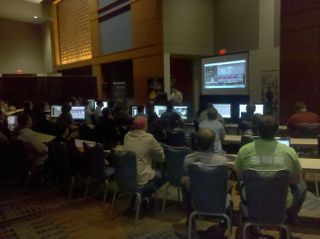ECGC 2011: NC Is A Developer Hog Pen
Based on feedback by game developers, North Carolina has become a massive hub for studios and potential recruits.

While attending ECGC 2011 this week, I set out with two objectives: (1) to find out what was going on with the PC gaming sector, and (2) why an expanding pot of developers is collecting in North Carolina.
With the latter goal, it seems that there are three central developer hot spots on this continent alone-- the California-West Coast region, Texas and Canada. So what makes this area so special? How is a state known for the Andy Griffith Show, Dawson's Creek, tobacco and corn fields, and vinegar-based BBQ the ideal place to make AAA titles? From what I gather, it just happened.
Thursday I spent some time with Red Storm Entertainment and talked about why the studio was located in NC. Of course, the reason is obvious: the founding members are actually from the area. Managing director Steve Reid was on hand but unable to answer specific questions without running them through Ubisoft first-- understandable given that I'm the press, it was late in the day, and we were both worn to the point that anything would fall out of our mouths.
But another Red Storm rep-- who transferred into the company a few years ago from the Midwest-- said the quality of living is better and the cost of living is cheaper (Epic, who moved to NC in 1999, agreed). The rep also called the area a developer hog pen. Actually, she didn't really say that-- she specifically said "hub" but for some reason my ears heard "hog pen" and I laughed, repeating it. She agreed that yeah, it could be considered as developer hog pen-- a farm of potential talent so to speak-- and then for a few moments we talked about driving down the highways and knowing you're in hog territory just by the smell. At this point, gaming talk had strayed way off course.
But whether it's a hog pen or a hub, the Triangle area (Raleigh, Durham, Chapel Hill) is a breeding ground for hopeful developers. This is in part due to the educational system-- Wake Technical Community College, Piedmont Community College (Western and Piedmont), NC State, the Art Institute of Raleigh-Durham and numerous other institutes-- who offer game-related degrees. Thus not only do local developers swoop in and grab potential AAA creators from an enormous, festering pool of talent, but outside companies like Seattle-based Bungie are even traveling across the country to personally take job submissions.
I spoke with Bungie's recruiting manager, engineering & infrastructure Jessica Owens who said that the company is growing and came to the ECGC specifically for recruiting-- obviously the company wasn't displaying anything given it's no longer with Microsoft and currently working on a new mystery title. Unfortunately, I couldn't get the details of the current project, but she pointed me to the website which lists the current openings. What I did find out is that Bungie converted an old (AMC?) movie theater into a studio, and that everyone works together in one huge, open (three-story) space. The work environment sounded just as fun as the products it produces, and the images on the Bungie website illustrates that environment setting rather well.

The state's surge in developer-related growth can be attributed to the efforts by the Triangle Game Initiative-- the trade association behind the ECGC-- which consists of "market-leading" companies and "prominent industry figures." The board of directors itself consists of two reps from Epic, Alexander Macris from The Escapist, John Austin who at one time served at Emergent Game Technologies, and R. Michael Young, an Associate Professor of Computer Science at North Carolina State University.
Stay on the Cutting Edge
Join the experts who read Tom's Hardware for the inside track on enthusiast PC tech news — and have for over 25 years. We'll send breaking news and in-depth reviews of CPUs, GPUs, AI, maker hardware and more straight to your inbox.
During the show, I was introduced to John Austin (also the show's co-founder and conference chairperson as well as managing director / head coach of developer "incubator" firm Joystick Labs) who was kind enough to give me a few moments for a brief overview. According to Austin, three to four of the current board of directors got together and felt that the Triangle area needed promotion-- it especially needed to get the west coast's attention so that publishers would see more than just tobacco and corn fields. Thus started the Triangle Game Initiative, and just happened to launch at a time when publishers and developers were rapidly hiring new employees.
The TGI's first conference launched in 2009 and landed more attendees than expected. The second year was even larger, and finally this year the convention was moved into a larger space. Later on during the first keynote, Austin brought me up to speed while introducing Nvidia's senior vice president of content and technology Tony Tamasi.
"Our conference this year is bigger and better, and I know that's cliché, but our number one objective this year was to improve the content of our program and bring a better program to everybody that attends," he said. "The past couple of years, we've had a about 50 sessions and I’ll be honest with you, it was tough enough to get that forty-ninth or fiftieth submission into the conference. We have over a hundred new submissions to this year's conference and that's enabled us to select some real high quality presentations that I hope you've enjoyed today. We've expanded the exhibit space, we added the art exhibit out in the lobby with art from some of the artists from local game companies and schools, our exhibit area is better-- obviously we moved from across the street into a much bigger space which gives us a little bit more elbow room. We've added Unreal University this year which the couple of time I've been in there it's been extremely crowded."

There's no question that Epic had a huge presence at the show. I saw Epic head honcho Mark Rein a few times marching through with a small gathering of followers, and the Unreal University itself was curtained off and jam-packed for all eight sessions. The actual ECGC conference consisted of seven separate sessions each hour in seven different categories: business of games, advanced learning, programming visual arts, game design, social and mobile, and game fundamentals. But in total, ECGC 2011 offered fifty-six different classes over a span of two days.
The first class I actually attended centered on the new tax incentive passed last year and is set to go in effect this year. One of Canada's biggest attractions is its tax incentives for game developers, and now North Carolina has followed suit. The credit is equal to a percentage of expenses paid in excess of $50,000 in developing the media, platform or engine. To get this credit, developers must be working on Interactive Digital Media (IDM), or rather, a computer-controlled virtual environment with a set goal.
The North Carolina Department of Commerce states the following: "IDM products are defined by those used for electronic media distribution, including file download over the Internet; contains a computer-controlled virtual universe with which an individual who uses the program may interact in order to achieve a goal; and/or contains a significant amount of at least three of the following five types of data: animated images, fixed images, sound, text, and 3D geometry. This includes game platforms, game engines, and games that have both entertainment and serious applications - N.C.§105-129.56."
But the credit doesn’t cover similar media used for internal purposes, political advertising or software specifically designed for gambling (even Texas Hold-em you can play on your smartphone). Ultimately this credit will be ideal for start-up developers and really won't have a huge impact on local developers who rake in millions of bucks annually.
Another class I attended showed how Dominic Cianciolo of NetherRealm Studios and his team created the in-game cinematics for the upcoming Mortal Kombat reboot. Naturally it's all about presentation, especially the opening sequence that establishes the overall story and sets up the additional sequences. The big challenge here was that the team was essentially re-establishing the Mortal Kombat brand, harmonizing the history, building out the world established in prior games, and so on. He also talked about gameplay requirements in the story including opponent balance and environment balance.
Other sessions offered by ECGC 2011 included developing next-gen 3D mobile gaming on Android by Nvidia's Lars Bishop, creating effective stereoscopic 3D presented by EA's Anthony Marinello, facial rigging in Gears of War 3 presented by Epic's Jeremy Ernst, HTML 5 and other modern browser gaming tech presented by Google's Lilli Thompson and so much more. Honestly, if I could have split myself into eight individuals, I would have visited every single session while also stalking specific developers and their PR contacts.

But let's be honest. The show wasn't a huge event like E3 in Los Angeles or PAX East in Boston-- it's understandably compact given its origin. It wasn't visually overwhelming either as far as the exhibit hall was concerned, remaining low key in presentation and overall dimly lit. Epic displayed the Samaritan demo in real-time behind closed doors (which I missed thanks to eating too much junk food) but primarily focused on Unreal University rather than sampling Gears of War 3 or even Bulletstorm. James Tan from Epic and Markus Arvidsson from Teotl Studios were flown in to offer sessions on building levels in just one hour, making a racing game for iOS, using PhysX and APEX Clothing in UE3 and more. Lenovo supplied the desktops and notebooks for all UU attendees to use.
Vicious Cycle was at the event showcasing its upcoming console game Earth Defense Force: Insect Armageddon (which totally rocked, thanks Jim!), and Funcom was promoting Bloodline Champions (thanks Glen for getting me hooked) among others. The various colleges were out there and other non-gaming developers were promoting their various uses of Unity3D and Unreal Engine 3. Insomniac Games and Red Storm weren't really showing product, but seemingly out looking for new talent. There was also what I considered to be the Microsoft Kinect / PlayStation Move killer which could bring a new level of gameplay and Windows interaction to the PC environment-- more on that later.
By the time the convention concluded Thursday evening, I felt that I accomplished one of my objectives at least. I discovered that North Carolina is growing as a game developer hub (or hog pen as I called it). It doesn't seem to have reached the level of California at this point, but there's potential thanks to the state's new tax incentive. The cost of living is low and the quality of life is high so I’m told, and developers like Epic, Red Storm and Insomniac seemingly serve as huge magnets. What small developer wouldn't want to be associated or influenced by these top-tier studios?
As the local developer community grows and outside publishers and developers begin to take more of an interest in the collective pool, the show will undoubtedly get bigger and bigger as shown over the last few years. ECGC probably won't-- and perhaps shouldn't-- compete with E3 in the coming years, but ultimately it may come down to what's cheaper for the publisher/developer: exhibit on the west coast or exhibit on the east coast. We're already seeing a growing number with PAX East as it is.

Bottom line, hopeful game designers may want to look into getting a degree at a facility within the area, as according to one particular recruiter, the industry is looking to the east for new blood. And thanks to the Triangle Game Initiative, highly-respected individuals like David Perry, Tony Tamasi and Mark Cerny are brought in to beef up the ECGC's content, to prove it's not just a gathering of locals, but a full-fledged gaming convention.
As pointed out by Mark Cerny in his Day 2 keynote, GDC started out as the Computer Game Developers Conference back in 1988, a small function launched by Chris Crawford who managed to cram around twenty-seven designers into his San Jose-based living room. Now it's one of the biggest gaming events of the year.
-
awood28211 I couldn't read this whole article. Meh. As a previous resident of the RTP area and employed there for some time... Talent excluded, the area IS a hog pen. You're in a city or in the country, neither of which is attractive to be in on a personal level. It's a place where surrounding places actually exist on single roads. Take Morrisville for instance, just outside Cary and south east of Durham. The welcome to and now leaving signs are at each end of the road that the country club is on... which by the way is a pretty short road anyway.Reply
While working there... yeah, i could was Torvalds zoom in driving his fancy-shmancy car from my office window.. So what, I wasn't impressed... then or now. Fortune 50 company payroll was nice but the area is puke.
Good advice.. DON'T MOVE THERE. -
xenorage ReplyHow is a state known for the Andy Griffith Show, Dawson's Creek, tobacco and corn fields, and vinegar-based BBQ the ideal place to make AAA titles?
Umm couldn't mention Michael Jordon, UNC, DUKE, IBM, Nortel Networks, RedHat, NASCAR, Bank of America, First Citizens, Wachovia, Goodrich... Ect.
Dang last I checked NC is the TOP IT and Silicone technology state on the east coast. I am sorry for your ignorance but from someone who has been in IT/R&D and technology for the last 20 years working for 3 fortune 500 companies in the state of NC, I find you a bit stereotypical.
As far as what you or awood28211 think of the area well that is personal preference, so it depends on the beholder. I prefer the country side to the congested cities but not everyone does. -
ghaleon1980 @awood28211: Are you joking? Raleigh NC is a fantastic place to live. It is frequently a destination of relocation by many people from the midwest and northeast. The city is beautiful, the economy is robust, it's population (Raleigh, Cary and Durham) is a healthy 1.8 million people and its 2 hours from the beach/2 hours from the mountains. What the heck are you talking about? Eh, to each his own I guess...Reply
Most Popular



